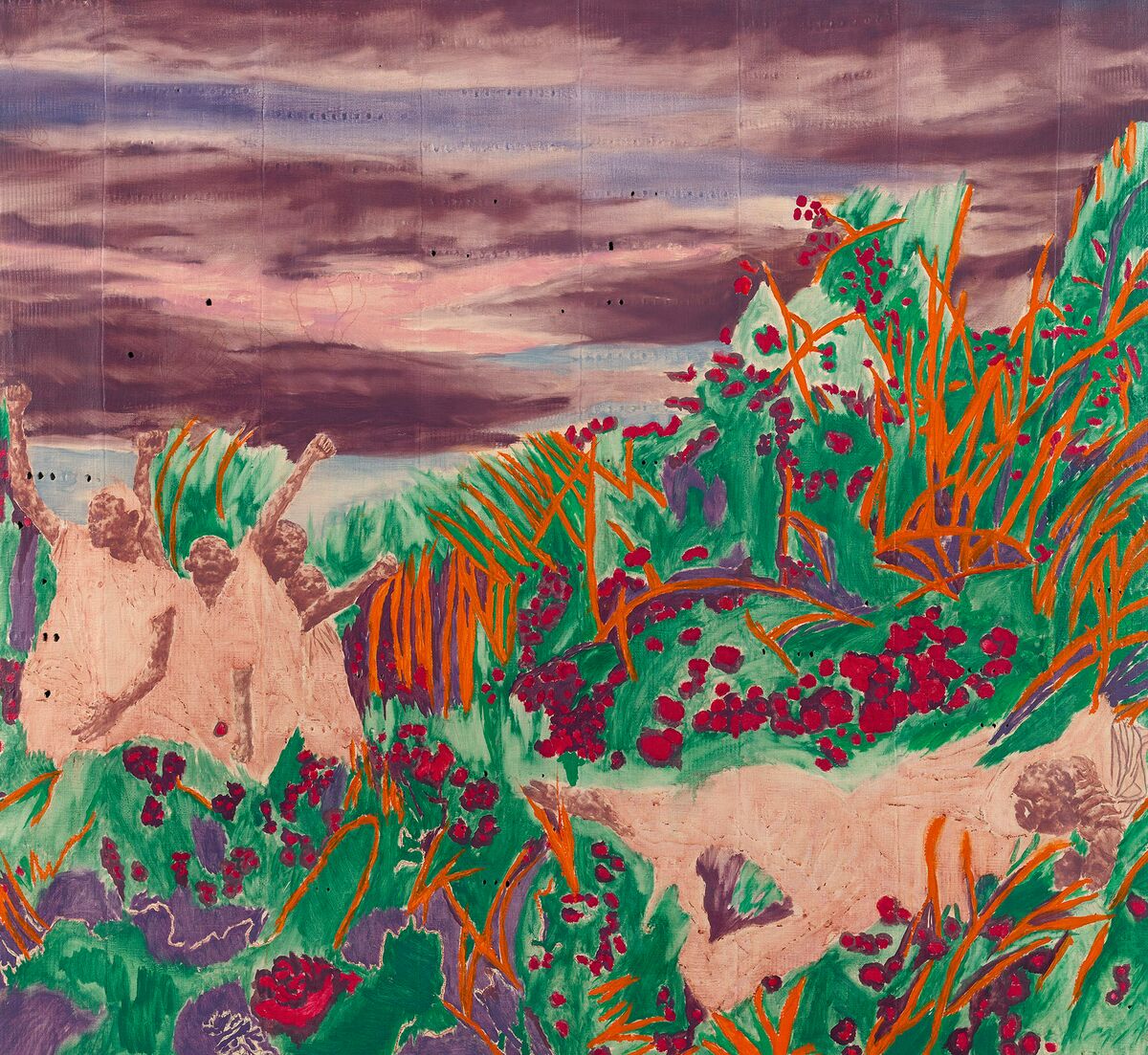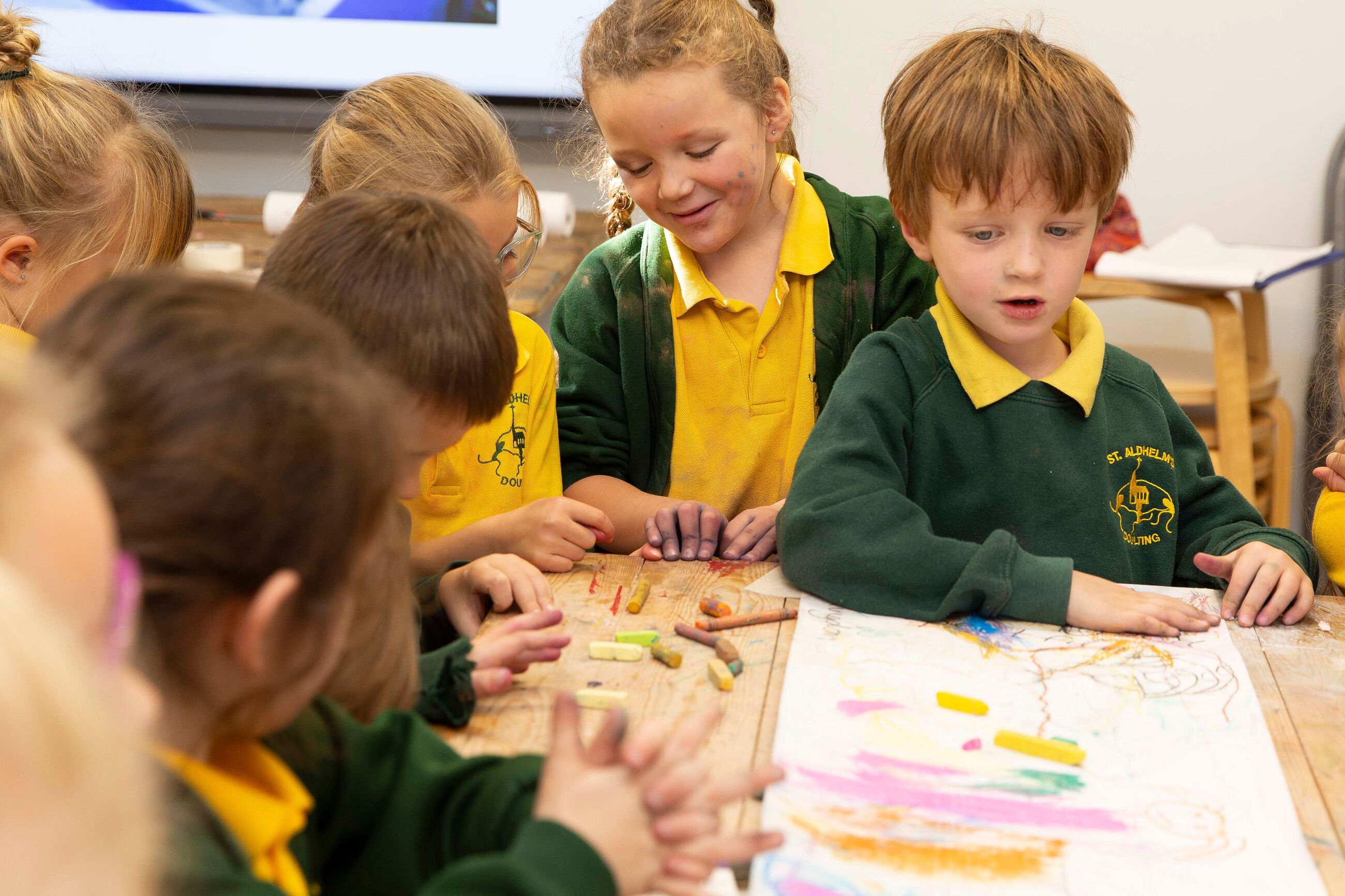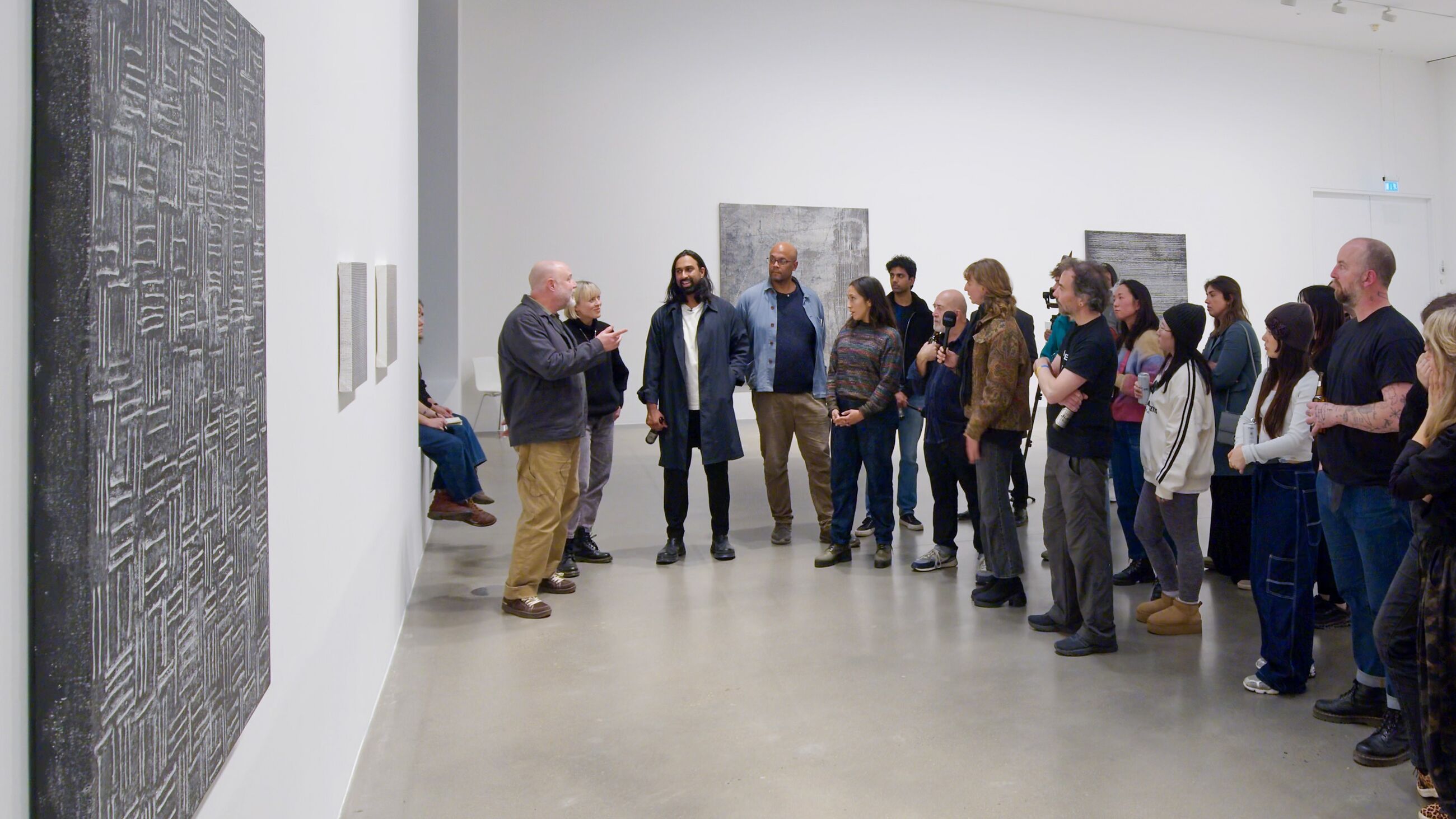Exhibition Learning Notes: ‘Chillida in Menorca’

Installation view, ‘Chillida in Menorca’ at Hauser & Wirth Menorca, from 11 May to 27 October 2024 © Zabalaga Leku. San Sebastián, VEGAP, 2024. Photo: Damian Griffiths
Exhibition Learning Notes: ‘Chillida in Menorca’
This resource has been produced to accompany the exhibition ‘Chillida in Menorca’ at Hauser & Wirth Menorca from 11 May – 27 October 2024.
Click here to download a PDF of this resource.
About Eduardo Chillida
Eduardo Chillida (1924 – 2002) is one of the foremost Spanish sculptors of the 20th century and this year we celebrate the artist’s centenary. With a pioneering practice that embraces small-scale sculpture, plaster work, drawing, engraving and collage, Spanish artist Eduardo Chillida is best known for his prominent monumental public sculptures, such as ‘Peine del viento (The Comb of the Wind)’ and ‘Elogio al horizonte (Eulogy of the Horizon)’.
Chillida was born in San Sebastián in 1924. From 1943 until 1946 he studied architecture at the University of Madrid before turning his attention to drawing. In 1948 Chillida was awarded a scholarship to study in Paris and on his return to Spain in 1951, he began experimenting in materials that resonated with the Basque region’s industrial heritage such as iron. Chillida settled in Hernani and, in 1952, he set up an iron foundry, learning techniques from a local blacksmith. Throughout his career, he incorporated a variety of materials such as steel, wood, concrete, alabaster, granite and paper. Paper allowed him to explore different techniques including engraving, collage, and gravitations, enabling him to experiment with form and line through cutting, overlapping and suspension. In 2000, Chillida opened Chillida Leku, an exhibition space and sculpture park converted from a historic farmhouse, harmoniously integrating his works into the landscape.
Throughout his lifetime Chillida was recognised with numerous awards, including the Grand International Sculpture Prize at the Venice Biennale (1958), Kandinsky Prize (1960), Grand Award for Arts in France (1984), and Jack Goldhill Award from the Royal Academy of Arts in London (1996).

Eduardo Chillida working in his studio in Menorca, 1996 © Zabalaga Leku, San Sebastián, VEGAP, 2024. Photo: Hans Spinner
Chillida in Menorca
Since 1989, Eduardo Chillida and his family spent many summers in Menorca, developing a strong connection with the island. Setting up an outdoor studio at ‘Quatre Vents’, the family house he created with his wife Pilar Belzunce in Alcaufar, he found a quiet place to work on some of his chamotte clay sculptures, called ‘Lurras’, surrounded by the fields and their dry-stone walls. A few of these pieces are presented for the first time at Hauser & Wirth Menorca.
Chillida was captivated by the Mediterranean white light, which contrasted with what he referred to as the Basque Country’s black light; as well as the wind, the open-air quarries of local ‘marès’ stone, the landscape and the monuments from the Talayotic period. These Talayotic T-shaped ‘taules’ inspired some of his works. He commented: ‘The light in Menorca is magnificent. The island has a beautiful history, there is a very interesting stone culture, and it’s so full of wind. So, I have heard it said: Menorca, wind and stones’ (Pons Fraga, 2024).
What does the exhibition look like?
The exhibition ‘Chillida in Menorca’ celebrates the artist’s deep connection to the island through a major presentation of sculptures and works on paper, including several created during his stay in Menorca. More than 60 works spanning half a century, from 1949 to 2000, the exhibition exemplifies the breadth of Chillida’s work, highlighting the artist’s connection to the island and its natural environment.
The exhibition opens with a series of large format ‘gravitations’. To create them, Chillida cut out papers that he superimposed as a collage, as if they were reliefs on paper, but instead of glue, he introduced space, joining the papers together with a thread. Under their own weight, the sheets separate, allowing air to circulate between them, as if they were floating without gravity.
Similarly to the ‘gravitations’, in ‘Mural G-56’ and several drawings on paper across the exhibition, Chillida used ink to continue to explore positive and negative space, capturing abstract concepts such as rhythm, limit and movement with geometrical motifs.
‘Chillida in Menorca’ exhibits a series of well-known steel sculptures and wooden reliefs, which highlight Chillida’s interest in making space visible through the shapes that surround him. One of these sculptures is ‘Proyecto para un monumento (Project for a Monument)’, a play of scales that links up with the artist’s numerous public monuments, the interior space is configured through three solid blocks that fit together.
In Menorca, Chillida modelled many of his ‘Lurra’ sculptures, a series named after the Basque word for ‘earth’. They are made of chamotte clay, a type of clay that can be fired in large blocks without breaking. Chillida was attracted by this property of the material and explored the infinite possibilities of shapes it allowed. The titles of these pieces relate the works to their place of origin: those with an ‘M’ in the title are among those made in the Menorca studio, while those with a ‘G’ were made in Grasse, in the south of France, where his friend and ceramist Hans Spinner had his workshops and where Chillida became familiar with the material.
Also, in chamotte clay there is a series of works called ‘Óxidos (Oxides)’, which acquired a distinctive colour and texture using black copper oxide and the double firing process. These feature abstract geometric motifs, which correspond to his abstract ink drawings and are painted on both sides of the works, inviting the viewer to experience a sense of space.
The final rooms of the exhibition highlight the artist’s passion for nature. Chillida incorporated organic forms in his early works on paper and steel sculptures and emphasised the natural qualities of the materials he worked with, such as granite, alabaster and felt, among others. An example of this is the granite piece ‘Escuchando a la piedra III (Listening to Stone III)’, (1996), in which the artist removed just enough material to reveal the form and emphasise the impenetrability of the rock. Similarly, exploring the versatility of steel, the sculpture ‘Lotura XXVII (Bond XXVII)’ (1992) is composed of longitudinal arms created in the forge, without moulds, and manipulated to open and then wrap around themselves.
Having grown up by the Atlantic Ocean, Chillida recalled spending hours contemplating the waves and referred to the sea as his teacher. ‘Homenaje a la mar IV (Homage to the Sea IV)’ (1998), from the series of tributes which Chillida dedicated to figures or phenomena that inspired him, evokes the rugged Cantabrian coastline through geometrical shapes hewn out of alabaster in contrast to an uncut stone base. In dialogue with this sculpture is ‘Homenaje a la arquitectura II (Homage to Architecture II)’ (2000), a reference to Chillida’s ongoing exploration of forms – whether organic or architectural – and their structuring in space.
Placed in dialogue with the Mediterranean Sea is ‘Proyecto Peine del viento I (Comb of the Wind Project I)’ (1966). The study is part of the artist’s most important series of work, culminating in three monumental steel sculptures embedded in the rocks on the seashore of San Sebastián, a work which fuses materials, land, sea and air. The work is an invitation to look.
The delicate corten steel ‘Saludo a los Pájaros II (Salute to the Birds II)’ (2000) by Eduardo Chillida stands outside the large window at the end of the North Galleries, surrounded by trees and views of the harbour. Appearing almost weightless, the sculpture denotes Chillida’s mastery of material and form as well as his continuous passion for natural phenomena.

Installation view, ‘Chillida in Menorca’ at Hauser & Wirth Menorca, from 11 May to 27 October 2024 © Zabalaga Leku. San Sebastián, VEGAP, 2024. Photo: Damian Griffiths
What are the major themes of his works?
Space and Matter
Eduardo Chillida’s main interest lies in the dialectics between matter and space. He draws parallels between space and the spirit as both are intangible yet can be felt and experienced. On the other hand, materials are characterised by their solidity and tangible qualities. Chillida thought that, for his works to function within this material-space dialectic, what is full must be full and heavy, and what is empty must be purely empty, visible and accessible space. For him, empty forms were a trick, because they hide inaccessible spaces within, and it is in this void that the energy of his work resides.
Limits
The concept of limits preoccupied Chillida throughout his career: sculpture would not exist if there were no limits in space, between matter and emptiness. The artist was fascinated by the difficulty to determine the limit, a line which, like the horizon, both unites and divides elements and cannot be touched. From his house in Menorca, Chillida would spend hours contemplating the moonrise over the horizon.
Architecture
In 1943, Chillida began studying architecture, which he later abandoned in favour of drawing at Madrid’s Círculo de Bellas Artes in 1947. The principles of architecture would accompany him when creating artistic work. As such, he called himself an ‘architect of emptiness’, a builder of spaces. Within his works, Chillida avoided the use of right angles, he felt that they limited the dialogue between other angles; right angles are not present in nature.
Philosophy
Chillida’s work stems from his desire to answer the questions he asked himself in order to understand the world around him. He posed philosophical questions and concerns about nature, the being of things, time, density, speed and space, which he then translated into his artworks. For Chillida, the process of knowing, experimenting and discovering is more important than knowledge itself, refusing absolute truths.
Furthermore, Chillida’s work refers to universal values, by dedicating some of his artworks to fraternity, freedom, peace and tolerance. This is reflected in some of his monumental sculptures, which are presented as meeting places and spaces for dialogue between equals.
Nature
Nature is at the origin of Eduardo Chillida’s work and was always an inexhaustible source of inspiration for the artist. Throughout his career, Chillida rendered homage to the natural world by means of different materials and techniques: paper, alabaster, steel, granite. The materials stand out for their naturalness and the sculptor tries to reveal the inherent beauty of each one of them, respecting their essence and without altering their condition. The artist’s view of nature is one of astonishment in the face of the unknown; it is from nature and its laws that the questions of his work arise.
Location
Eduardo Chillida’s sculptures are closely linked to their surroundings. The first place that left a mark on him was his hometown, San Sebastián, a city nestled between the sea and mountains, where the natural elements and the rhythm of the tides exerted enormous influence. There, he became aware of the relationship between time and space. Inspired by the locations where he lived and worked, some of Chillida’s works reflected the influence of the Menorcan and Basque landscape. In the latter was Chillida Leku (‘leku’ meaning ‘place’ in Basque), a museum established during his lifetime by converting a historic farmhouse and harmoniously integrating his works into the landscape
Many of Chillida’s public sculptures are located outdoors, and interact with nature, showing us the value the artist placed on the environment. For example, ‘Elogio del horizonte (Eulogy to the Horizon)’ and ‘Peine del viento XV (Comb of the Wind XV)’ are found in very special locations from which we can contemplate the sea. Through his sculpture, Chillida defined the place, inviting us to come closer and look beyond.
Music
The influence of music is often present in Eduardo Chillida’s work. Matter and space are essential components of sculpture, much as sound and silence are fundamental aspects of music. Likewise, words like rhythm, time, and vibration apply to both music and Eduardo Chillida’s work. The sculptor approaches the materials through sound, while the titles of many of his works make reference to music. Chillida also created homages to composers, Bach was unquestionably his favourite, with many of Chillida’s works being dedicated to the composer.

Installation view, ‘Chillida in Menorca’ at Hauser & Wirth Menorca, from 11 May to 27 October 2024 © Zabalaga Leku. San Sebastián, VEGAP, 2024. Photo: Damian Griffiths
Related artists
Constantin Brancusi. Chillida admired Brancusi, one of the great sculptors of the 20th century, whom he met in Paris. He was struck by the coherence between the work and the person, but above all by the special relationship that the Romanian-born artist had with matter. Brancusi’s work is marked by a profound respect for matter, of which he kept the essential. He was the creator of a new sculptural language based on the purification of forms. He eliminated details in order to emphasise the essence of the material.
Georges Braque. The French painter is known for being one of the initiators of Cubism. Chillida met him in Paris because they were both represented by the Maeght Gallery. Braque recommended him to read Eugen Herrigel’s Zen in the Art of Archery, a book that influenced his understanding of the creative process. His painting of his later years is distinguished by the purification of forms and the presence of birds floating weightlessly in space. He did not try to copy nature but to put himself in unison with it.
Alexander Calder. Chillida was particularly fond of the American sculptor, with whom he met on several occasions, particularly at the Maeght Foundation in Saint Paul de Vence, where the gallery’s artists met in the summer. Calder is famous for his wire sculptures and mobiles. His works of abstract and geometric forms reveal his interest in spatial relationships. When he died, Chillida paid tribute to him. It is a hanging sculpture that gravitates and moves according to its own weight.
Alberto Giacometti. The Swiss sculptor and painter is distinguished by a very personal style centred on the human figure. He is internationally renowned for his extremely thin, elongated sculptures. These bronze figures evoke the human figure seen from afar. In a conversation Chillida asked him why he made his sculptures so small and Giacometti replied that he did it to enlarge the space.
Joan Miró. Miró was a painter, sculptor and ceramist born in Barcelona. His work is marked by a unique and personal language related to nature, music and poetry. Although his early work tended towards figuration, it gradually became increasingly schematic and abstract. Chillida met Miró through his gallery owner Aimé Maeght and they became close friends. When he died, he honored him by looking at the way he drew. He realised that Miró’s lines were convex and his

Vista d’instal·lació, ‘Chillida a Menorca’ a Hauser & Wirth Menorca, de l’11 de maig al 27 d’octubre 2024 © Zabalaga Leku. San Sebastián, VEGAP, 2024. Foto: Damian Griffiths
Glossary
Alabaster
A type of stone with translucent properties. Used in sculpture and decorative objects, it is notable for its malleability and is soluble in water.
Chamotte clay
Ceramic material obtained from fired ceramic, ground and reduced to grains, its particularity is that it does not break during firing.
Bach
Johanne Sebastian Bach was a German musician and composer of the Baroque period. Chillida dedicated a number of his works to this artist and his many compositions.
Gravitations
The name Eduardo Chillida gave to his gravity-activated 3D collages made from paper and string.
Negative Space
Negative space is the space that surrounds a sculpture and is just as important as the object itself, negative space helps to define the boundaries of positive and negative space.
Positive Space
Positive space refers to the significant elements within art or design that draw the viewer’s attention, shaping the composition’s focal points.
Public Work
Public works are artworks which are visible and accessible to the general public, usually situated within the public realm, commissioned and paid for by local governing bodies.
Sculpture
Three dimensional artworks created using carving, casting or modelling techniques, resulting in the shaping of volume and space.
Questions for Discussion
Choose a drawing by Chillida and observe carefully. What is full? What is empty? What is the main figure: the black or the white elements? Would your answer change if we inverted the colours? What dialogue is created between matter and space?
How does the work relate to other art and to broader visual culture, for example music, theatre, science, philosophy, geography, mathematics or ecology?
Is the material presence of the artwork important? How would your response to the work change if the artist used a different material? What associations or connotations do the materials carry?
Stand in front of a sculpture by Eduardo Chillida. Are we obliged to contemplate the work from a certain place or in a certain way? Observe the work from different perspectives: what sensations does it produce? How do you think the change of perspective influences the perception of the work?

Installation view, ‘Chillida in Menorca’ at Hauser & Wirth Menorca, from 11 May to 27 October 2024 © Zabalaga Leku. San Sebastián, VEGAP, 2024. Photo: Damian Griffiths
Practical Activities
The sculpture should delimit a place, form a space. Think about how to surround the void, how can we delimit the void? We invite you to look into the void and shape it. For Chillida, space is not nothingness, it is charged with a special energy. With his work, the artist frames places and invites us to see beyond.
Negative space is the space that surrounds a sculpture and is just as important as the object itself, negative space helps to define the boundaries of positive and negative space. Look one of the sculptures and rather than drawing the sculpture itself, try and draw the space around and in-between it.
Supplementary Research
Resources
1 / 10









